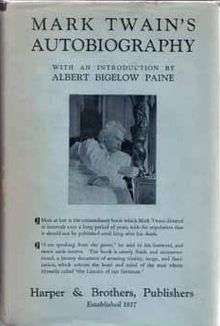Autobiography of Mark Twain
Autobiography of Mark Twain or Mark Twain’s Autobiography refers to a lengthy set of reminiscences, dictated, for the most part, in the last few years of American author Mark Twain's life and left in typescript and manuscript at his death. The Autobiography comprises a rambling collection of anecdotes and ruminations rather than a conventional autobiography.
Mark Twain Project Edition

A three-volume edition of the complete text was published between 2010 and 2015.
Volume 1
The first volume of a three-volume edition of the complete text was published in November 2010, the 100th anniversary year of Twain’s death, edited by The Mark Twain Project of The Bancroft Library at University of California, Berkeley and published by University of California Press;[1][2][3] it runs to 760 pages. The volume is available online.[4][5]
The book includes introductory material explaining how Twain’s autobiography was written. Then follows Twain’s early, fragmentary attempts at writing it; and the text of his autobiographical dictations (the main series). The editors supply historical annotation.[6]
Volume 2
Volume 2 was published in October 2013 and runs to 736 pages.[7] The book is also available free online.
Volume 3
The third and final volume of the Mark Twain Project edition was published in October 2015. It contains 792 pages. This volume contains the notorious "Ashcroft-Lyon Manuscript" and a section titled "Closing Words."[8]
Previous publication

Twain himself had published 'Chapters from My Autobiography' in twenty-five installments in the North American Review in 1906-7.[9] Since Twain's death in 1910, a number of different editors have made attempts to impose some order on the whole of the material by selection and reorganization, producing several decidedly different published versions of The Autobiography. The first of these was published in 1924 by Harper & Brothers Publishers.
Twain's own attempt
Twain first started to compose an autobiography in 1870, but proceeded fitfully, abandoning the work and returning to it as the mood took him. In a 1904 letter to William Dean Howells, he wrote: “I’ve struck it! And I will give it away—to you. You will never know how much enjoyment you have lost until you get to dictating your autobiography.” [10] By 1904 Twain had embarked on what he called his “Final (and Right) Plan” for telling the story of his life. However, after 1907 he again seems to have let the book languish; in 1908-9 he hardly added to it at all, and he declared the project concluded in 1909, after the death of his youngest daughter Jean. His innovative notion — to “talk only about the thing which interests you for the moment” — meant that his thoughts could range freely. Twain thought his autobiography would be most entertaining if he went off on whims and tangents in non-sequential order.[11]
Twain outlined a plan in 1899 for an autobiographical work which was to be published (according to different accounts of the episode) either "100 years from now" or "100 years after his death." A manuscript note in the Mark Twain Papers (UC Berkeley) indicates a 100-year ban was what he was contemplating. Twain did produce a preface 'From the Grave' claiming that the book would not be published until after his death, which allowed him to speak with his "whole frank mind."
The manuscript and typescript materials of the Autobiography are in the Mark Twain Papers at The Bancroft Library, University of California, Berkeley.
Early editions
The first edition of the Autobiography was published by Twain's personal friend and literary executor Albert Bigelow Paine, and consisted of twenty-two fragments presented in the order Twain composed them, including the first four months (January–April 1906) of the Autobiographical Dictations. The edition received rather poor reviews. In 1940, editor and historian Bernard DeVoto published another selection in Mark Twain in Eruption, arranged by topic and heavily edited. In 1959 Charles Neider rejected both Paine's and DeVoto's approaches and rearranged the material to match the chronology of a standard autobiography. In 1990 (republished February 2010) Twain scholar Michael J. Kiskis edited an edition of the autobiography titled Mark Twain’s Own Autobiography: The Chapters from the North American Review. In spite of these previous efforts, around half of the Mark Twain Project text will be seeing publication for the first time.
References
- ↑ Churchwell, Sarah (2010-11-01) "Mark Twain: Not an American but the American", The Guardian. Retrieved 2010-11-01.
- ↑ "Mark Twain's Autobiography, Finally Released". CBS News. May 24, 2010. Retrieved August 13, 2010.
- ↑ Mark Twain Project Online (2010-11-01) "Mark Twain Papers & Project: A Brief History"
- ↑ Autobiography of Mark Twain, Volume 1 Mark Twain Project Online, home page. Retrieved, 8/3/2012. Berkeley, CA: UC Berkeley's Library Systems Office.
- ↑ Introduction: Paragraph 184
- ↑ Mark Twain Project . 2010, 2008. Autobiography of Mark Twain, Volume 1.
- ↑ University of California Press Autobiography of Mark Twain, Volume 2
- ↑ University of California Press Autobiography of Mark Twain, Volume 3
- ↑ "Mark Twain's own autobiography: the chapters from the North American review", Google Books. Retrieved 2010-05-27.
- ↑ Cox, James M. (November 2002). Mark Twain: The Fate of Humor (Mark Twain & His Circle). University of Missouri Press. p. 295. ISBN 978-0-8262-1428-7.
- ↑ Dobson, James E. (2014). "Mark Twain, Memory, and the Failures of Historicism". Mark Twain Annual. 11 (1): 62–76.
External links
- The Autobiography of Mark Twain Summary & Study Guide on eNotes.com.
- Autobiography of Mark Twain Volume 1: Introduction
- Autobiography of Mark Twain Volume 2
- Autobiography of Mark Twain Volume 3
- This is Mark Twain, combines video slideshows, images, interviews with the editors and other Mark Twain scholars, and audio clips of excerpts, to explore the Autobiography of Mark Twain.